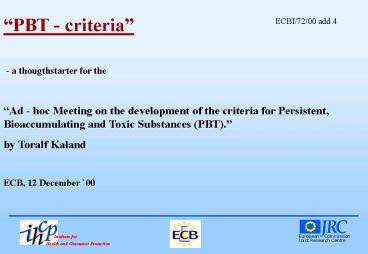PBT criteria - PowerPoint PPT Presentation
1 / 17
Title:
PBT criteria
Description:
Directive 98/8/EC (Biocides) Directive 91/414/EEC (Plant Protection Products) ... chem, new chem, WFD, biocide....) PBT exp. PB(T) exp. PB exp. Exp. ... – PowerPoint PPT presentation
Number of Views:347
Avg rating:3.0/5.0
Title: PBT criteria
1
PBT - criteria - a thougthstarter for the
Ad - hoc Meeting on the development of the
criteria for Persistent, Bioaccumulating and
Toxic Substances (PBT). by Toralf Kaland ECB,
12 December 00
ECBI/72/00 add 4
2
The aim of the presentation 1. Give a
overview and outline some thoughtstarters on
the PBT- concept 2.
Identification of elements for further discussion
in relation to Directive
67/548/EEC.
3
- PBT - introduction
- 1. Discussed or under discussion in several
international bodies, and in
different framework / context - - OECD - UNECE LRTAP
- - US - EPA - UNEP POP
- - OSPAR - HELCOM
- 2. Examples of EU Legislations relevant to
evaluation of PBT substances - Directive 67/548/EEC (C L)
- Regulation 793/93/EEC and Directive 93/67/EEC
(New and existing chemicals) - Directive 98/8/EC (Biocides)
- Directive 91/414/EEC (Plant Protection Products)
- Water Framework Directive
-
4
PBT - introduction (cont.) 3. Common
fundamental basis / characteristic -
potential emission should be reduced for the
identified PBTs - development of testing
strategy and criteria
5
The PBT-pyramide
I
Regulatory approache(s)
?
III
PBT - content
Implementation
2
6
- I . Potential Regulatory approache(s)
- 1. Priority Setting / selection of
hazardous substances - example OSPAR - initial selection procedure of
substances of possible concern - POP - selection of POP-candidates
- 2. Risk Assessment / Risk Reduction Measure
- example EU - new and ex. chemicals / the
Open Sea Scenario - 3. Identification and selection of
PBT-substances covered by - Directive 67/548/EEC
- 4. Other approache(s) ........
7
- II . PBT - content / definition
- 1. Criteria
- i). Hazard based criteria (C L)
- PBT
- PB(T)
- PB
- ii). Risk based criteria (POP, OSPAR, ex.
chem, new chem, WFD, biocide.) - PBT exp.
- PB(T) exp.
- PB exp.
- Exp. potential exposure
Stepwise procedure
8
- II . PBT - content / definition (cont.)
- iii). Potential exposure
- load, emission (volume, use category, ....)
- occurance / monitoring
- POP the potential for long-range atmospheric
transport - - Vp lt 1000 Pa
- - T1/2 (atmospheric) gt 2 days
- - monitoring data showing that the
substance is found in remote regions
9
- II . PBT - content / definition (cont.)
- 2. Criteria and cut off values
- non - compartment specific
- - one set of criteria and corresponding cut off
values - compartment specific
- - several set of criteria and values
- - aquatic (marine, limnic)
- - terrestrial (in soil and above the ground)
- - sediment
- - groundwater
- - air
10
- II . PBT - content / definition (cont.)
- 3. Substances which not fulfill the PBT-
criteria / safety net - metals
- endocrine substances
- other substances ?
11
- II . PBT - content / definition (cont.)
- 4. Some key issue
- many different options
- test strategy available test protocols and
information - the criteria and cut-off values will normally
depend on the pre - defined regulatory approach
of the PBT concept
12
- III . Implementation of the PBT - concept
- potential regulatory possibilities and benefits
in the framework ? - possible outcome and consequences ?
- roles and responsibilities (DG ENV, ECB, MS,
IND) ?
13
- Example
- OSPAR / DYNAMEC
- - initial selection
- - ranking
- - expert judgement and
- advises
14
- Example OSPAR / DYNAMEC (cont.)
- Proposed cut-off values for the Selection
Critera used in the Initial Selection Procedure
- Persistency (P) ...........................
Half-life (T1/2 ) of 50 days and - Liability to bioaccumulate (B) ....log Kowgt 4
or BCF gt 500 and - Toxicity (T) ....................................
.. T aq acute L(E)C50 lt 1 mg/1, long term NOEC
lt 0,1 mg/l - or
- T mammalian CMR or chronic toxicity
- different types available information allowed
to use is specified
15
- Example UNEP POP
- Proposed cut-off values for the UNEP POP
negotiation POP - candidates - Persistency (P) ...........................
Water half-life (T1/2 ) of 2, 6 months - Sediment/soil half-life (T1/2 ) of 6
months - Liability to bioaccumulate (B) ....log Kowgt 4,
5 or BCF gt 5000 - Toxicity (T) ....................................
.. all substances provided with Risk Phrases
suggesting evidence of harm to humans or the
environment , and cancer Group 1, 2A, 2B (IARC). - Additional values on half-life (atmosphere),
Vp, occurance
16
- Example EU new and existing chemicals / Open
Sea Scenario - Preliminary draft on proposed cut-off values for
Open Sea Scenario. Selection for risk reduction
measure. - Persistency (P) ...........................
Marine water half-life (T1/2 ) of 60 days
- Sediment half-life (T1/2 ) of 180
days - Liability to bioaccumulate (B) ....log Kowgt 4,
5 or BCF gt 5000 - Toxicity (T) ................................. T
aq acute L(E)C50 lt 1 mg/1, long term NOEC
lt 0,1 mg/l - or T mammalian CMR or
chronic toxicity - Emission/load ..............................
text proposal under drafting - different types available information allowed
to use is proposed
17
(No Transcript)

